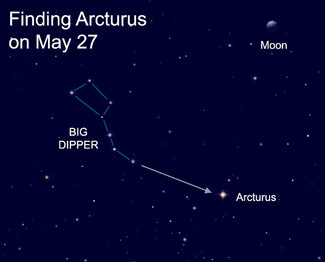Arcturus: The Star of the Show
Last updated 6/13/2023 at 11:05am
What a beautiful Chicago evening it was on May 27, 1933. Crowds had begun gathering at the fairground earlier that day, for this was an event they had awaited for many years.
Much as they do today, event organizers had engaged the services of a famous star to throw the switch to open the festivities. And then, as anticipation reached a peak, it was time.
At exactly 9:15 p.m., the pavilions and waterways of the fair were bathed in colorful light, the music of bands, bells and choruses, and the roar of cannons and rockets brought the thousands of visitors to cheers and tears. The 1933 Century of Progress Exposition was officially open!
Perhaps you've heard of the Century of Progress Exposition. What you may not know, however, is what radio personality Paul Harvey might have called "the rest of the story," for the star that threw the switch that night was not of the human variety, nor was it a famous animal celebrity of the day.
No, the star that opened the great Exposition reached in from its perch nearly 216 trillion miles above Chicago. Its name is Arcturus.
Arcturus is the fourth brightest star in our night sky, and the brightest in the constellation Boötes, the herdsman. Look for its yellowish-orange glow high in the eastern sky not long after dark this week. You can easily confirm its location by using the handle of the Big Dipper – now standing high in the northeastern sky in the early evening – to point your way toward it.
Gaze toward Arcturus and you will be seeing a red giant star some 25 times larger and 170 times more luminous than our sun. It appears as it does because it lies some 37 light-years from Earth.
Arcturus was one of the first stars ever to receive a proper name. In his classic book "Star Names and Their Meanings," author R. H. Allen devotes several pages to this star's mythological references. In ancient times, sky watchers knew it as the "Watcher" or the "Guardian"; the Arabs knew it by two names which translate as "the Lance-Bearer" and "the Keeper of Heaven." Today, we use a name that comes from the ancient Greek word Arktouros, meaning "Bear Guard."
In 1635, Arcturus was the first star ever to be seen in daylight with a telescope (besides the sun or a supernova). Today, you can do this with even a modest backyard instrument – if, of course, you know exactly where to aim it.
It was 90 years ago, on the night of May 27, 1933, that astronomers at the nearby Yerkes Observatory focused this star's light onto a photocell and transmitted the electrical current it generated to flip the switch that illuminated the fair.
So of all the stars in all the heavens, why did Exposition officials choose Arcturus? Because, at the time, the star was believed to lie 40 light-years from Earth, and that meant that its light that fell onto a photocell and illuminated the great fair that night would have left the star in 1893 – while Chicago's previous World's Fair was still underway!
And now you know ... the "rest of the story."
Visit Dennis Mammana at dennismammana.com.




